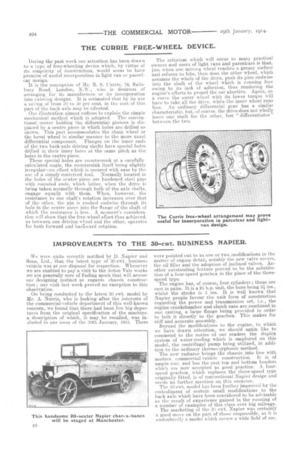IMPROVEMENTS TO THE 30-cwt. BUSINESS NAPIER.
Page 30

If you've noticed an error in this article please click here to report it so we can fix it.
We were quite recently notified by D. Napier and Sons, Ltd., that, the latest type of 30-cwt. business vehicle was at our disposal for inspection. Whenever we are enabled to pay a visit to the Acton. Vale works we are generally sure of finding much that will arouse our designing instinct as regards chassis construction; our visit last week proved no exception to this observation.
On being conducted to the latest 30 cwt. model by Mr. A. Norris, who is looking after the interests of the commercial-vehicle department of this well-known concern, we found that there had been few big departures from the original specification of the machine, a description of which, it may be recalled, was included in our issue of the 30th January, 1913. There were pointed out to us one or two modifications in the matter of engine detail, notably the new valve covers, the oil filler and the adoption of inclined valves. Another outstanding feature proved to be the substitution of a four-speed gearbox in the place of the threespeed type.
The engine has, of course, four cylinders.; these are cast in pairs. It is a 24 h.p. unit, the bore being 34 ins., whilst. the stroke is 5 ins. It is well known that Napier people favour the unit form of construction regarding the power and transmission set, i.e., the engine crankehamlaer and clutch case are combined in one casting, a large flange being provided in order to bolt it directly to the gearbox. This makes for stiff and accurate a.ssembly. Beyond the modifications to the engine, to which we have drawn attention, we should again like tocommend to the notice of our readers the duplex system of water-cooling which is employed on this model, the centrifugal pump being utilized, in addition to the ordinary thermo-syphonic method.
The new radiator brings the chassis into line with modern commercial-vehicle construction. It is of ample size, and has the cast top and bottom headers which are now accepted as good practice. A fourspeed gearbox, which replaces the three-speed type originally fitted, is of conventional Napier design and needs no further mention on this occasion.
The 30-cwt. model has been further improved by the embodiment of certain small modifications to the back axle which have been considered to be advisable as the result of experience gained in the running of a number of examples of this class over big mileage. The marketing of the 3e cwt. Napier was certainly a good move on the part of those responsible, as it is undoubtedly a model which covers a wide field of use.






































